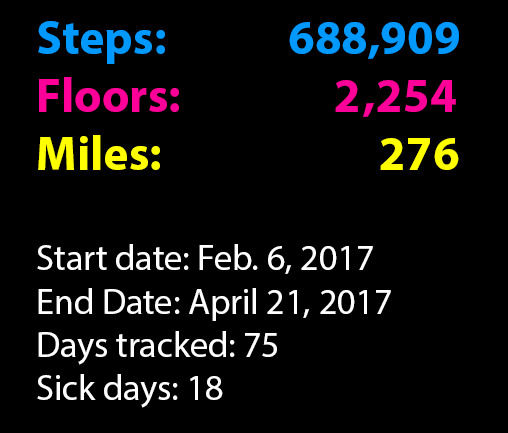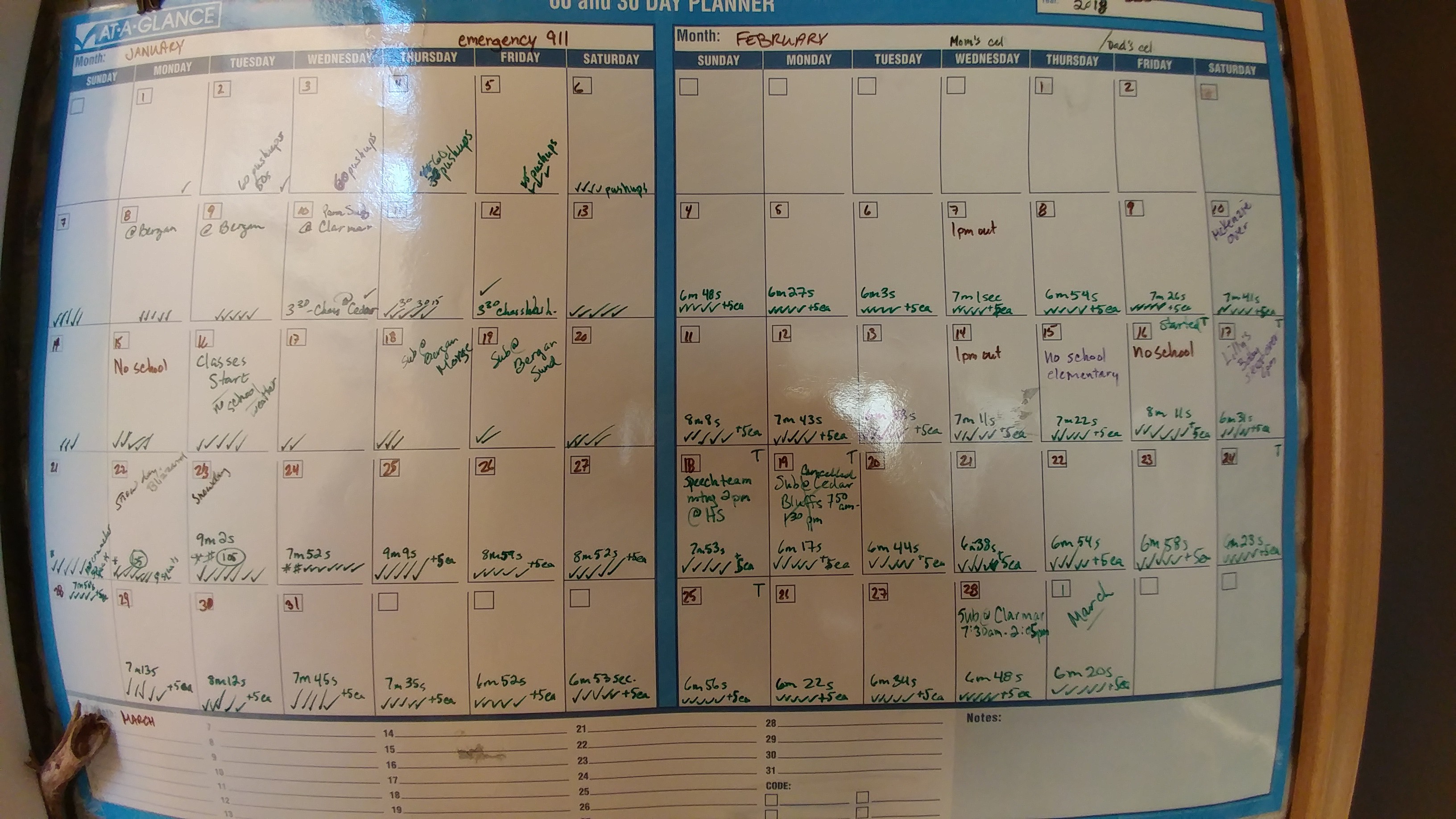Applying behavior science to my fitness routine gave me the motivation I needed to hit a bragworthy endurance goal
 image source
image source
When I started posting a number as my Facebook status, friends and acquaintances began asking questions. By the time I posted 1,000, they all understood what I was doing: achieving an endurance challenge to do 1,000 push-ups in one day.
That they knew what I was doing turned out to be an important part of my getting there.
 Illustration by the author.
Illustration by the author.
It was a long journey that started with a class assignment to apply behavior change in an actual experiment on a person or animal. I was pursuing a master?s degree in educational psychology with two specializations: neuropsychology and positive psychology. For the assignment, I decided to run an experiment on myself.
In this article, I?ll share what I learned in that experiment, how it led to me pursuing an endurance challenge, and how you can do it too.
Learning About Behavior Change Firsthand
I chose to design an experiment on myself because my exercise routine had fizzled out and I couldn?t seem to get motivated to start a new one. I?d been faithfully using the Tiny Habits method created by BJ Fogg and had made good progress with my fitness goals. Then I started working more hours, which resulted in getting sick (I?m a substitute teacher), and my exercise routine fell by the wayside.
The assignment seemed like the perfect opportunity to jump-start a new routine. Using operant conditioning as the basis for changing my behavior, I set out to track all of my activity for 75 days. I didn?t use punishment of any kind but instead focused on the positive reinforcement of a checkmark on a wall calendar in my kitchen.
By now, most of us are familiar with the cue ? routine ? reward idea. To motivate myself to establish a consistent routine, I created two visual cues:
- A 3′ 4′ dry erase wall calendar
- A green check mark on each day that I met my goal
I thought of a third cue, running shoes placed in the bathroom, but didn?t end up using that one.
The experiment
I already considered myself ?moderately active? and wanted to increase the amount of exercise I was doing from an average of two days per week to four days per week. After researching the difference between moderate and intense activity, I started tracking my steps, stair climbs, and miles?plus any other physical activity I engaged in, like Vinyasa yoga, shoveling snow, or push-ups.
My workout routine included cardio (jumping jacks, kicks, punches), bodyweight squats, push-ups, crunches, and lunges ? anything that got my heart rate up for 11 to 22 minutes. I didn?t have to work out every day; I just needed to do it three or four times per week. My Fitbit did all the tracking.
The results
Out of 75 days, I worked out 54 times for an average of 21 minutes. Here?s how everything else broke down:
 Illustration by the author.
Illustration by the author.
Looks impressive, right? I suppose, but I knew I could do better. What I discovered through this process is that operant conditioning alone couldn?t keep me motivated to change my behavior. That little check mark was awesome to see, but something was missing.
Reframing and Adding a Fun Challenge
I started by reframing my minimum commitment as something that could give me a consistent sense of competence. All I had to do every day was one push-up, one bodyweight squat, and one crunch in 30 seconds. (This almost always led to doing more.) The only other requirement was that I couldn?t work out longer than 15 minutes.
Every morning I got up at 6 a.m., timed my workout, and then got my kids up and ready for school. We were out the door by 7:30 a.m. every day.
After a few months, I noticed that I was getting bored, so I introduced a new challenge:
How fast can I do 20 push-ups, 20 bodyweight squats, and 20 crunches?
It turned out I was pretty fast.
 Photo credit: Kori D. Miller
Photo credit: Kori D. Miller
On Facebook on March 7, 2018, I posted:
5 minutes, 54 seconds ? The time it took to do 105 pushups, body weight squats, and crunches. I hate it when I really don?t want to exercise and I try to convince myself I don?t have time, but then this happens. Damn.
My tactics for exercising when crunched for time were having a big payoff. Adding the speed component to the challenge helped too.
The Big Challenge: 1,000 Push-ups in One Day
It?s not often that a book influences me so much that I upend my goals completely.
In late summer of 2018, I finished listening to Living with a SEAL: 31 Days Training with the Toughest Man on the Planet by Jesse Itzler. By the time Itzler finished training, he could do 1,000 push-ups in a single day.
If he could do it, why couldn?t I? Challenge accepted!
I?d made progress on sticking with my fitness plan every day. What I needed to do now was develop a strategy for handling a bigger challenge.
Why an endurance challenge?
Taking on a big endurance challenge was a way for me to keep increasing my level of fitness. The push-pull of a daily training regimen builds resilience. The American Psychological Association lists exercise and moving toward one?s goals as 2 of 10 ways to build resilience.
Endurance exercises help you maintain proper posture, and the stronger muscles that result from them make it easier for you to perform everyday tasks like lifting objects, climbing stairs, and standing, reducing risks of injury. Strength training also helps keep bones strong, among all of the other known benefits of exercise in general.
And to be sure, the goal appealed to me on the basis of bragging rights. How many people do you know who?ve completed 1,000 push-ups in a day?
Why push-ups?
A push-up challenge appealed to me specifically because it?s an exercise that builds upper body strength and develops the core muscles in the lower back, pelvic floor, hips, and buttocks. Push-ups also tone the tricep muscles in the upper arm?no more jiggling.
You don?t need any equipment. (This is one of the main reasons I started bodyweight training.) If you don?t need equipment and can exercise anywhere, then you have fewer excuses for not working out.
You also can incorporate squats, abdominal crunches, and pull-ups into your challenge if you like. This is an awesome combination that strengthens your entire body. Strong leg muscles are very important as we age. Many older adults fall because their core and leg muscles are weak. These muscles also help you stand up.
I chose push-ups, however, and below I?ll share some information on how to do them correctly. But first, I?ll talk about how I set up my training to address the motivation problems I?d had in earlier fitness routines.
The Keys to Staying Motivated
Determined to figure out the secret sauce for motivating myself, I read everything I could about motivation theory. My favorite concept, and by far the one that was most helpful to me, is the self-determination theory of motivation.
In a nutshell, I learned that we have three basic needs that shape our motivation, and that each one must be satisfied for us to feel motivated to change our behavior. All three are essential to our feeling of well-being. They are:
- Competence: We need to experience mastery; our ability to control outcomes.
- Autonomy: We need to have a sense of control in our lives and be ?us??to live in a way that is congruent with our sense of self.
- Relatedness: We need to feel a sense of connectedness to other people.
I fell short in two areas in previous fitness goals.
First, I fell short on competence when my routine was interrupted by illness or other causes. This created a feeling of lack of control over my fitness program: less mastery. If my routine got interrupted, I felt like a failure because I didn?t have a plan for those situations as part of the normal course of life.
Second, I lacked relatedness in my plans. I didn?t have a workout buddy or accountability partner, which also meant I didn?t have any cheerleaders. On those days when I was sick, it could have been helpful to hear an encouraging word from a partner. And me helping someone else would have been beneficial too.
For this challenge, I needed to make sure I had everything in place for competence, autonomy, and relatedness?and especially for competence and relatedness, my previously weak areas.
 Illustration by the author.
Illustration by the author.
To address the competence issue, I created ?if/then? scenarios to help me stay consistent through difficult times. Having a plan for handling difficulties was essential, as it gave me confidence that I could work through challenges instead of giving up.
To address the relatedness issue, I shared my progress on Facebook and was mindful of using it in a way that would provide true support.
?If/then? scenarios for competence
The biggest blow to my sense of competence had been missing days for a variety of factors. So it was important to create a plan for what I would do when I couldn?t meet my larger goals due to illness, schedule changes, or other circumstances.
I worked through a series of ?if/then? scenarios to handle situations that I knew would threaten my sense of competence in order to make sure I would achieve something.
- What if I?m feeling a little sick, but not ?down for the count?? I could set a minimum to do that day. In my case, it was 25 push-ups. ?If I?m feeling a little sick, then I?ll just do my minimum of 25 for that day.?
- What if I?m feeling really sick, perhaps with a stomach bug? On that day, I resolved to do my absolute minimum of one push-up. ?If I?m feeling really sick, then I?ll just do one push-up.?
- What if the only time I can do push-ups is at work? I had breaks, so if I could find a discreet spot?the bathroom floor, the hallway, a classroom?I could get it done. Doing a set of 25 doesn?t take longer than about 30 seconds once you develop the strength for it. ?If I don?t get my push-ups in at home in the morning, then I?ll do them at work during my break.?
- What if I just can?t seem to squeeze in my minimum? I resolved to always do at least one. One push-up takes mere seconds to complete, and I might discover that I could do a few more. ?If I can?t do my minimum, then I?ll do at least one push-up.?
- What if I get injured? I planned to assess the injury and rest. If I could do one push-up, then I?d do it and pick up where I left off as soon as possible. It would really depend on the injury. I ?tweaked? my shoulder periodically, and that forced me to slow down. Basically, I had pain, but it didn?t prevent me from doing at least one. ?If I have an injury, then I?ll adjust my target number for a healthy goal.?
- What if I have a headache? As a migraine sufferer, I don?t advocate exercising with headaches. I didn?t have any while I completed this challenge because I?ve learned to control them. In the past when I didn?t listen to my body, my headaches intensified. As a result, I resolved that even a plan to take a day off is better than no plan at all. ?If I have a migraine, then I?ll rest and drink water and resume the next day.?
And I told myself, ?Remember: You get a check mark every time you complete your minimum, even if it?s just one!?
A few years ago, I spoke with Stanford researcher BJ Fogg. He mentioned that it?s easier to restart a habit that got derailed than to start a new one.
So don?t give up!
Strategies for relatedness
I wrote earlier that one area in which I had faltered in the past was relatedness. My tendency is to ?go it alone,? but I learned the hard way that doing so was detrimental to my fitness goals.
Let?s be honest, working out is a lot more fun with other people, even when they?re not physically with you. They provide external motivation. When I see the steps of someone I?m connected to via my Fitbit, that encourages me to get moving.
When you want to make a change of any kind, it?s critically important to surround yourself with supportive people. When I began posting my number on Facebook, most of my friends, acquaintances, and family cheered me on. Going public with my goal gave me the sense of connection I needed.
This strategy was not without challenges. There was one person in particular who took a few jabs at me. I could have simply ignored or unfriended this person, but instead, I explained the purpose of what I was doing to them. After that, they were much more supportive.
Here are a few more ?if/then? scenarios I created for handling situations that challenged relatedness and connection:
- What if that person doesn?t change their tune? I would tell them to stop commenting on my posts. ?If someone is being negative on my posts, then I will ask them to stop commenting.?
- And what if they don?t stop? Well, that would be a clear indication that the person doesn?t respect me. ?If someone persists in negative posting after I?ve asked them to stop, then I?ll unfriend them.?
- What if it is a family member on Facebook who isn?t being supportive? I would unfriend them also. ?If the person behaving badly is a member of my family, then I?ll still unfriend them.?
- But what if I still have to see that family member in person? I would be polite. My mantra is ?Let it go.? What I mean by this is that not every negative behavior someone else exhibits deserves or needs my attention. ?If I see someone I?ve unfriended on Facebook, then I will be polite, and it will be unnecessary for me to bring it up.?
Really what this comes down to is being comfortable with establishing boundaries with people. Think of them as ?do not cross? lines. If the person crosses them, your ?if/then? needs to kick into gear.
Is this always easy? It?s surprisingly easy on social media but admittedly can be more challenging face-to-face. Some people aren?t comfortable with confrontation.
Your own ?if/then? situations for relatedness will differ. Some might involve spouses, partners, or children ? your inner circle ? who might not be supportive. If that?s the case, you might want to discuss it with a counselor to help you better manage those relationships. But hopefully you?ll have a supportive inner circle.
Other ?if/then? scenarios for relatedness you could build around:
- ?If I?m feeling like skipping my workout, then I?ll call a friend and tell him or her about my challenge and my reasons for doing it, which will help me feel more inspired.?
- ?If I feel like I?m not making the kind of progress I?d like to see at any point, then I?ll ask a coach to help me refine my form and give me pointers.?
- ?If I reach a new milestone (like every 100 push-ups), then I?ll post a celebratory selfie along with my number on Facebook.? (You can use if/then scenarios for positive events too.)
Knowing my motivation and planning for situations that could challenge it were key to reaching my goal.
The 3 P?s of Goal Attainment
There are things you need to think through when embarking on a fitness or endurance challenge. I based my thinking on the ?3 P?s? of goal attainment: plan, persist, and prosper.
Plan: The logistics of completing so many push-ups isn?t always easy. Sometimes you?ll find yourself doing sets in odd places (like the back or front of a classroom, a bathroom floor, or a hallway). Decide on the time of day and place that works best for you, but also have backups.
Persist: You have to pace yourself. Working to exhaustion isn?t the objective. Think, ?This is a marathon, not a sprint.? Set a daily minimum and maximum number of push-ups and a rate of increase as you reach each new level. I increased my count by 25 every day. This is where my ?if/then?s really supported me. When sick I completed my minimum (100) most days, but if I really couldn?t, then I did 25 (and had I been really ill, then I would have done 1, all following my ?if/then? plans). When I felt stronger, I picked up where I had left off before getting sick. If that was 300, then I completed 325 for the day.
Prosper: Each daily accomplishment fed the next. If I could do 500 push-ups one day, I certainly could do 525 the next. What was 25 more? This kind of thinking creates a positive feedback loop.
But here?s the most critical part of prospering ? I surrounded myself with people who encouraged me to accomplish what some believed was a crazy goal. I posted my progress to Facebook and had my ?if/then?s to handle any situation that might have previously blindsided me.
Developing the Training Plan
I trained by increasing the number of push-ups I did each day that I possibly could. The progress looked something like this:
- August 29: I was at 250 push-ups.
- September 1: I completed 300 push-ups.
- November 7: I realized that adding 25 to my daily count would get me to 1,000 by mid-December, and that became my goal. Game on!
- November 25: I completed 425 push-ups.
- December 10: I hit the halfway mark?500 push-ups.
- December 11: I went for it and reached 1,000.
Yes ? I went from 500 one day to 1,000 the next.
Crazy, right? I don?t know about other people who set out to do something like this, but for me, once I got past 700 on December 11, mentally I was ?all in.? Since I wasn?t teaching, I had all afternoon before ping-pong club to see if I could keep going.
When I reached 950 around 3 p.m. and had to leave for ping-pong, I realized there was no way I was starting over on December 12. I had to reach 1,000, so I did the last 50 later that evening.
Recovery wasn?t all that bad, but I think it?s because I spread the sets out and had been doing them for days. I had some soreness in my chest, but I?d been doing hundreds of push-ups per day before this challenge, so recovery was never that bad.
The hardest part was psyching myself up to reach the next target if I tweaked my left shoulder, because that meant I had to back off to give it time to heal before pushing forward. On December 11, that didn?t happen, so I kept going the next day. Then I was so close to the finish line, I had to cross it. (Interestingly enough, this is the same feeling I had when I finished my first 5K a few years back.)
My training plan, then, was based more on how my body felt and how it seemed to be responding to the effort?and not on any set timeframe. If I felt good, I increased the number of push-ups I did. As I did more, my body got stronger and it became easier to increase the number I did, until I was able to make that big jump in the last few days.
Apps and other tools
If you plan to tackle a fitness challenge, there are lots of tools available. I like Fitbit, but the activity tracker you use is a matter of preference. For habit tracking, I?m using a Panda Planner right now, but in the past, I used a simple wall calendar. Before that, I used an app called Habit Bull.
How to do it
- Choose a start date and an end date. It?s possible to complete 1,000 push-ups in 31 days as Itzler did, but that doesn?t need to be your goal. Your end date is something you can change, of course, depending on how your body responds.
- Write down your ?what if?? scenarios. This is how you?ll handle the unexpected situations that arise when you?re completing any challenge, that is, implementing or changing a behavior.
- Determine your daily minimum and maximum. Write it down. This is important because (1) it ties back to your ?what if?? scenarios, and (2) setting a maximum keeps you from burning out. (Of course, you?ll be revising that maximum up as you succeed at each level.)
- Determine where and when you?ll do your challenge. I set targets to spread my push-ups out during the day: my first target was 100 before 8 a.m., 200 before 10 a.m., and so forth. You will build up to these targets in the beginning, but it?s important to plot them out and understand how to fit them in. Getting to your goal requires some creativity.
- Announce your goal and start date to your inner circle. I used Facebook to make updates.
- Track your progress. Do this every day. Use that little check mark to give yourself a mental high five.
- Share your progress. You can do this daily or every other day. The important part is that you?re sharing it with your cheerleaders regularly.
- Establish mini milestones. These can relate to transitioning from one type of behavior to a more difficult one by a specific date and/or hitting a set target by the end of a week.
- Celebrate your mini milestones. Those check marks are your daily high five, but you also need to reward yourself for the larger targets you hit. This can be anything that?s healthy, like a happy dance in your kitchen. (Though I?ll admit that when I hit 1,000 push-ups, the kiddos I was with gave me a Rice Krispie treat! This isn?t something I typically eat.)
How to do a push-up
For those of you who don?t know how to do a push-up correctly, here are some video instructions to get you started at almost any level.
This first one is from the US Marines, and it demonstrates proper form for push-ups. (It also shows pull-ups, if you?re interested in those.)
If you?re struggling with completing one military push-up, then start with knee push-ups:
And if knee push-ups are too challenging, try wall push-ups:
If you?re out of shape or have any misgivings, it?s always a good idea to check with your doctor before starting a new exercise routine.
Be Prepared for Unexpected Benefits
Not only did I experience all of the benefits of endurance challenges I listed above, but the effect of completing this challenge trickled into my writing life: I?ve become a more focused and productive writer.
From November 23, 2018, to January 19, 2019, I wrote one post every day for my new blog and submitted seven articles for publication. I write every day. Before, I wrote when I felt like writing.
I?ve published essays, books, and short stories in the past, but this is the most non-academic writing I?ve produced in two years.
Setting a big goal helped me get consistent with my fitness program, and that seems to have given me motivation to be more consistent with my other goals. The key takeaway for me has been a renewed sense of focus.
Now what?
For me, my next goal is training for my first half marathon. For you? The sky?s the limit, and no matter what you choose, you can get it done?one ?push-up? at a time.
To summarize:
- Define your challenge.
- Understand why you want to do it.
- Create a plan for accomplishing it, including ?what if?? and ?if/then? scenarios. Make sure you keep your motivation high by supporting your sense of competence and relatedness in particular: make yourself resilient to bumps in the road, and involve other people.
- Reward your efforts, big and small.
- Surround yourself with encouraging, supportive people.
- Track your progress.
- Rest when you get injured.
- Forgive yourself when you fall short.
- Pick up wherever you left off and keep moving forward.
Small, purposeful steps lead to big leaps. Enjoy the process. Relish your results. But most of all, believe in yourself.


